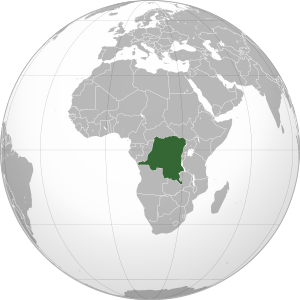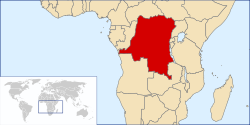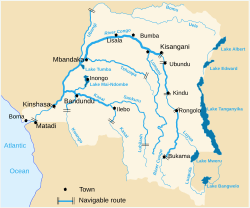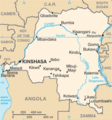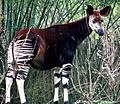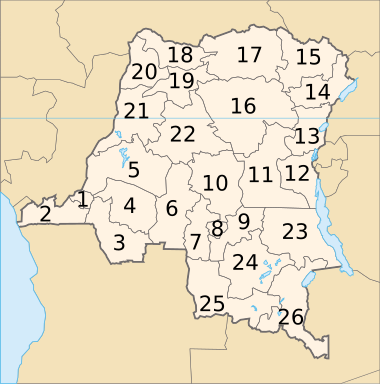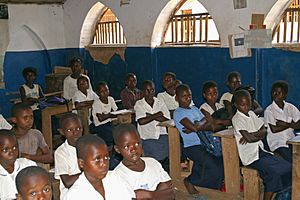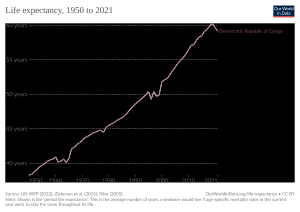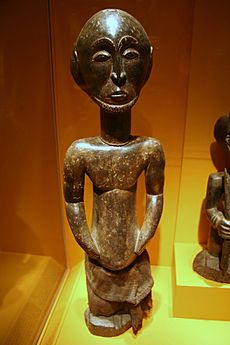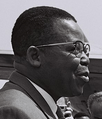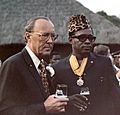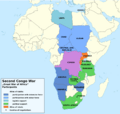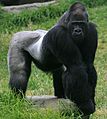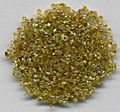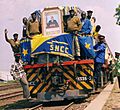Democratic Republic of the Congo facts for kids
Quick facts for kids
Democratic Republic of the Congo
République démocratique du Congo (French)
|
|
|---|---|
|
|
|
|
Motto: "Justice – Paix – Travail" (French)
"Justice – Peace – Work" |
|
|
Anthem: Debout Congolais (French)
"Arise, Congolese" |
|
| Capital and largest city
|
Kinshasa 4°19′S 15°19′E / 4.317°S 15.317°E |
| Official languages | French |
| Recognised national languages | |
| Religion
(2021)
|
|
| Demonym(s) | Congolese |
| Government | Unitary semi-presidential republic |
| Félix Tshisekedi | |
| Sama Lukonde | |
| Legislature | Parliament |
| Senate | |
| National Assembly | |
| Formation | |
|
• Colonised
|
17 November 1879 |
| 1 July 1885 | |
| 15 November 1908 | |
|
• Independence from Belgium
|
30 June 1960 |
|
• Admitted to the United Nations
|
20 September 1960 |
|
• Named Democratic Republic of the Congo
|
1 August 1964 |
| 27 October 1971 | |
|
• First Congo War
|
17 May 1997 |
|
• Current constitution
|
18 February 2006 |
| Area | |
|
• Total
|
2,345,409 km2 (905,567 sq mi) (11th) |
|
• Water (%)
|
3.32 |
| Population | |
|
• 2023 estimate
|
111,859,928 (14th) |
|
• Density
|
46.3/km2 (119.9/sq mi) |
| GDP (PPP) | 2023 estimate |
|
• Total
|
|
|
• Per capita
|
|
| GDP (nominal) | 2023 estimate |
|
• Total
|
|
|
• Per capita
|
|
| Gini (2012) | ▼ 42.1 medium |
| HDI (2021) | low · 179th |
| Currency | Congolese franc (CDF) |
| Time zone | UTC+1 to +2 (WAT and CAT) |
| Date format | dd/mm/yyyy |
| Driving side | right |
| Calling code | +243 |
| ISO 3166 code | CD |
| Internet TLD | .cd |
The Democratic Republic of the Congo (French: République démocratique du Congo), commonly referred to as DR Congo, Congo-Kinshasa or the DRC, is a country in central Africa. It was known as Zaïre from 1971 to 1997. It is the second largest country in Africa by area and the eleventh largest in the world. With a population of over 71 million, the Democratic Republic of the Congo is the nineteenth most populous nation in the world, the fourth most populous nation in Africa, as well as the most populous Francophone (French-speaking) country.
DRC borders the Central African Republic and South Sudan to the north; Uganda, Rwanda, and Burundi in the east; Zambia and Angola to the south; the Republic of the Congo, the Angolan exclave of Cabinda, and the Atlantic Ocean to the west. It is separated from Tanzania by Lake Tanganyika in the east. The country has access to the ocean through a 40-kilometre (25 mi) stretch of Atlantic coastline at Muanda and the roughly 9 km wide mouth of the Congo River which opens into the Gulf of Guinea. It has the second-highest total Christian population in Africa.
Contents
Etymology
The Democratic Republic of the Congo is named after the Congo River, which flows through the country. The Congo River is the world's deepest river and the world's third-largest river by discharge. The Comité d'études du haut Congo ("Committee for the Study of the Upper Congo"), established by King Leopold II of Belgium in 1876, and the International Association of the Congo, established by him in 1879, were also named after the river.
The Congo River was named by early European sailors after the Kingdom of Kongo and its Bantu inhabitants, the Kongo people, when they encountered them in the 16th century. The word Kongo comes from the Kongo language (also called Kikongo). According to American writer Samuel Henry Nelson: "It is probable that the word 'Kongo' itself implies a public gathering and that it is based on the root konga, 'to gather' (trans[itive])." The modern name of the Kongo people, Bakongo, was introduced in the early 20th century.
History
When the Belgian Congo became independent, its leaders fought each other. The Soviet Union and later the United Nations helped destroy the groups who wanted independence from the new country.
The Second Congo War, beginning in 1998, devastated the country. It involved nine African nations and some twenty armed groups. Despite the signing of peace accords in 2003, fighting continues in the east of the country. The war is the world's deadliest conflict since World War II, killing 5.4 million people since 1998. The vast majority died from conditions of malaria, diarrhea, pneumonia and malnutrition.
The Democratic Republic of the Congo was formerly, in chronological order, the Congo Free State, Belgian Congo, Congo-Léopoldville, Congo-Kinshasa, and Zaire (Zaïre in French). Though it is in the Central African United Nations subregion, the nation is also economically and regionally affiliated with Southern Africa as a member of the Southern African Development Community (SADC).
Geography
The DRC is located in central sub-Saharan Africa, bordered to the northwest by the Republic of the Congo, to the north by the Central African Republic, to the northeast by South Sudan, to the east by Uganda, Rwanda and Burundi, and by Tanzania (across Lake Tanganyika), to the south and southeast by Zambia, to the southwest by Angola, and to the west by the South Atlantic Ocean and the Cabinda Province exclave of Angola. The country lies between latitudes 6°N and 14°S, and longitudes 12°E and 32°E. It straddles the Equator, with one-third to the north and two-thirds to the south. With an area of 2,345,408 square kilometres (905,567 sq mi), it is the second-largest country in Africa by area, after Algeria.
As a result of its equatorial location, the DRC experiences high precipitation and has the highest frequency of thunderstorms in the world. The annual rainfall can total upwards of 2,000 millimetres (80 in) in some places, and the area sustains the Congo rainforest, the second-largest rain forest in the world after the Amazon rainforest. This massive expanse of lush jungle covers most of the vast, low-lying central basin of the river, which slopes toward the Atlantic Ocean in the west. This area is surrounded by plateaus merging into savannas in the south and southwest, by mountainous terraces in the west, and dense grasslands extending beyond the Congo River in the north. The glaciated Rwenzori Mountains are found in the extreme eastern region.
The tropical climate produced the Congo River system which dominates the region topographically along with the rainforest it flows through. The Congo Basin occupies nearly the entire country and an area of nearly 1,000,000 km2 (390,000 sq mi). The river and its tributaries form the backbone of Congolese economics and transportation. Major tributaries include the Kasai, Sangha, Ubangi, Ruzizi, Aruwimi, and Lulonga.
The Congo River has the second-largest flow and the second-largest watershed of any river in the world (trailing the Amazon in both respects). The sources of the Congo River are in the Albertine Rift Mountains that flank the western branch of the East African Rift, as well as Lake Tanganyika and Lake Mweru. The river flows generally west from Kisangani just below Boyoma Falls, then gradually bends southwest, passing by Mbandaka, joining with the Ubangi River, and running into the Pool Malebo (Stanley Pool). Kinshasa and Brazzaville are on opposite sides of the river at the Pool. Then the river narrows and falls through a number of cataracts in deep canyons, collectively known as the Livingstone Falls, and runs past Boma into the Atlantic Ocean. The river and a 37-kilometre-wide (23 mi) strip of coastline on its north bank provide the country's only outlet to the Atlantic.
The Albertine Rift plays a key role in shaping the Congo's geography. Not only is the northeastern section of the country much more mountainous, but tectonic movement results in volcanic activity, occasionally with loss of life. The geologic activity in this area also created the African Great Lakes, four of which lie on the Congo's eastern frontier: Lake Albert, Lake Kivu, Lake Edward, and Lake Tanganyika.
The rift valley has exposed an enormous amount of mineral wealth throughout the south and east of the Congo, making it accessible to mining. Cobalt, copper, cadmium, industrial and gem-quality diamonds, gold, silver, zinc, manganese, tin, germanium, uranium, radium, bauxite, iron ore, and coal are all found in plentiful supply, especially in the Congo's southeastern Katanga region.
On 17 January 2002, Mount Nyiragongo erupted, with three streams of extremely fluid lava running out at 64 km/h (40 mph) and 46 m (50 yd) wide. One of the three streams flowed directly through Goma, killing 45 people and leaving 120,000 homeless. Over 400,000 people were evacuated from the city during the eruption. The lava flowed into and poisoned the water of Lake Kivu killing its plants, animals and fish. Only two planes left the local airport because of the possibility of the explosion of stored petrol. The lava flowed through and past the airport, destroying a runway and trapping several parked airplanes. Six months after the event, nearby Mount Nyamuragira also erupted. The mountain subsequently erupted again in 2006, and once again in January 2010.
Biodiversity and conservation
The rainforests of the Democratic Republic of the Congo contain great biodiversity, including many rare and endemic species, such as the common chimpanzee and the bonobo (or pygmy chimpanzee), the African forest elephant, mountain gorilla, okapi, forest buffalo, leopard and, further south in the country, the southern white rhinoceros. Five of the country's national parks are listed as World Heritage Sites: the Garumba, Kahuzi-Biega, Salonga and Virunga National Parks, and the Okapi Wildlife Reserve. The Democratic Republic of the Congo is one of 17 Megadiverse countries and is the most biodiverse African country.
Conservationists have particularly worried about primates. The Congo is inhabited by several great ape species: the common chimpanzee (Pan troglodytes), the bonobo (Pan paniscus), the eastern gorilla (Gorilla beringei), and possibly a population of the western gorilla (Gorilla gorilla). It is the only country in the world in which bonobos are found in the wild. Much concern has been raised about great ape extinction. Because of hunting and habitat destruction, the numbers of chimpanzee, bonobo and gorilla (each of whose populations once numbered in the millions) have now dwindled down to only about 200,000 gorillas, 100,000 chimpanzees and possibly only about 10,000 bonobos. The gorillas, chimpanzee, bonobo, and okapi are all classified as endangered by the World Conservation Union.
Major environmental issues in DRC include deforestation, poaching, which threatens wildlife populations, water pollution and mining. From 2015 to 2019, the rate of deforestation in the Democratic Republic of the Congo doubled. In 2021, deforestation of the Congolian rainforests increased by 5%.
-
The endangered mountain gorilla; half of its population live in the DRC's Virunga National Park, making the park a critical habitat for these animals.
-
Found in the Congolian rainforests, the okapi was unknown to science until 1901
Administrative divisions
The country is currently divided into the city-province of Kinshasa and 25 other provinces. The provinces are subdivided into 145 territories and 32 cities. Before 2015, the country had 11 provinces.
| 1. Kinshasa | 14. Ituri Province | |
| 2. Kongo Central | 15. Haut-Uele | |
| 3. Kwango | 16. Tshopo | |
| 4. Kwilu Province | 17. Bas-Uele | |
| 5. Mai-Ndombe Province | 18. Nord-Ubangi | |
| 6. Kasaï Province | 19. Mongala | |
| 7. Kasaï-Central | 20. Sud-Ubangi | |
| 8. Kasaï-Oriental | 21. Équateur | |
| 9. Lomami Province | 22. Tshuapa | |
| 10. Sankuru | 23. Tanganyika Province | |
| 11. Maniema | 24. Haut-Lomami | |
| 12. South Kivu | 25. Lualaba Province | |
| 13. North Kivu | 26. Haut-Katanga Province |
Government and politics
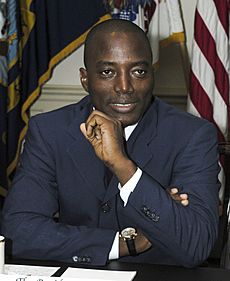
The 2006 constitution, also known as the Constitution of the Third Republic, came into effect in February 2006. Under the new constitution, the legislature remained bicameral; the executive was concomitantly undertaken by a President and the government, led by a Prime Minister, appointed from the party able to secure a majority in the National Assembly.
The government – not the President – is responsible to the Parliament. The new constitution also granted new powers to the provincial governments, creating provincial parliaments which have oversight of the Governor and the head of the provincial government, whom they elect. The new constitution also saw the disappearance of the Supreme Court, which was divided into three new institutions. The constitutional interpretation prerogative of the Supreme Court is now held by the Constitutional Court.
Although located in the Central African UN subregion, the nation is also economically and regionally affiliated with Southern Africa as a member of the Southern African Development Community (SADC).
Education
In 2014, the literacy rate for the population between the ages of 15 and 49 was estimated to be 75.9% (88.1% male and 63.8% female) according to a DHS nationwide survey. Primary education is not free nor compulsory, even though the Congolese constitution says it should be (Article 43 of the 2005 Congolese Constitution).
Actual school attendance has improved greatly in recent years, with primary school net attendance estimated to be 82.4% in 2014 (82.4% of children ages 6–11 attended school; 83.4% for boys, 80.6% for girls).
Health
The hospitals in the DRC include the General Hospital of Kinshasa. The DRC has the world's second-highest rate of infant mortality (after Chad). In April 2011, through aid from Global Alliance for Vaccines, a new vaccine to prevent pneumococcal disease was introduced around Kinshasa. In 2012, it was estimated that about 1.1% of adults aged 15–49 were living with HIV/AIDS. Malaria and yellow fever are problems. In May 2019, the death toll from the Ebola outbreak in DRC surpassed 1,000.
The incidence of yellow fever-related fatalities in DRC is relatively low. According to the World Health Organization's (WHO) report in 2021, only two individuals lost their lives due to yellow fever in DRC.
According to the World Bank Group, in 2016 , 26,529 people lost their lives on the roads in DRC due to traffic accidents.
Maternal health is poor in DRC. According to 2010 estimates, DRC has the 17th highest maternal mortality rate in the world. According to UNICEF, 43.5% of children under five are stunted.
United Nations emergency food relief agency warned that amid the escalating conflict and worsening situation following COVID-19 in the DRC, millions of lives were at risk as they could die of hunger. According to the data of the World Food Programme, in 2020 four in ten people in Congo lacked food security and about 15.6 million were facing a potential hunger crisis.
Air pollution levels in the Democratic Republic of the Congo (DRC) are very unhealthy. In 2020, annual average air pollution in the Democratic Republic of the Congo stood at 34.2 µg/m³, which is almost 6.8 times the World Health Organization PM2.5 guideline (5 µg/m³: set in September 2021). These pollution levels are estimated to reduce the life expectancy of an average citizen of the DRC by almost 2.9 years. Currently, the DRC does not have a national ambient air quality standard.
Largest cities
|
Largest cities or towns in the Democratic Republic of the Congo
|
||
|---|---|---|
| Rank | Name | Pop. |
| 1 | Kinshasa | 15,628,000 |
| 2 | Mbuji-Mayi | 2,765,000 |
| 3 | Lubumbashi | 2,695,000 |
| 4 | Kananga | 1,593,000 |
| 5 | Kisangani | 1,366,000 |
| 6 | Bukavu | 1,190,000 |
| 7 | Tshikapa | 1,024,000 |
| 8 | Bunia | 768,000 |
| 9 | Goma | 707,000 |
| 10 | Uvira | 657,000 |
Culture
The culture reflects the diversity of its numerous ethnic groups and their differing ways of life throughout the country—from the mouth of the River Congo on the coast, upriver through the rainforest and savanna in its centre, to the more densely populated mountains in the far east. Since the late 19th century, traditional ways of life have undergone changes brought about by colonialism, the struggle for independence, the stagnation of the Mobutu era, and most recently, the First and Second Congo Wars. Despite these pressures, the customs and cultures of the Congo have retained much of their individuality. The country's 81 million inhabitants (2016) are mainly rural. The 30% who live in urban areas have been the most open to Western influences.
Music
The DRC has its influences on Cuban rumba, originally kumba from Congo and merengue. And those two later give birth to soukous. Other African nations produce music genres derived from Congolese soukous. Some of the African bands sing in Lingala, one of the main languages in the DRC. The same Congolese soukous, under the guidance of "le sapeur", Papa Wemba, have set the tone for a generation of young men always dressed up in expensive designer clothes. They came to be known as the fourth generation of Congolese music and mostly come from the former well-known band Wenge Musica. The musical artist Elizo Kisonga, who now lives in England, is originally from Congo.
Sports
Many sports are played in the DRC, including football, basketball, and rugby. The sports are played in numerous stadiums throughout the country, including the Stade Frederic Kibassa Maliba. As Zaire they participated in the 1974 FIFA World Cup.
Internationally, the country is especially famous for its professional basketball NBA and football players. Dikembe Mutombo is one of the best African basketball players to ever play the game. Mutombo is well known for humanitarian projects in his home country. Bismack Biyombo, Christian Eyenga, Jonathan Kuminga, and Emmanuel Mudiay are others who gained significant international attention in basketball. Several Congolese players and players of Congolese descent—including strikers Romelu Lukaku, Yannick Bolasie, and Dieumerci Mbokani—have gained prominence in world football. DR Congo has twice won the African Cup of Nations football tournament.
DR Congo's women's national volleyball team lastly qualified for the 2021 Women's African Nations Volleyball Championship. The country featured a national team in beach volleyball that competed at the 2018–2020 CAVB Beach Volleyball Continental Cup in both the women's and the men's section.
Media
Newspapers of the DRC include L'Avenir, Radion Télévision Mwangaza, La Conscience, L'Observateur, Le Phare, Le Potentiel, Le Soft and LeCongolais.CD, a web-based daily. Radio Télévision Nationale Congolaise (RTNC) is the national broadcaster of the Democratic Republic of the Congo. RTNC currently broadcasts in Lingala, French, and English.
Literature
Congolese authors use literature as a way to develop a sense of national consciousness amongst the people of the DRC. Frederick Kambemba Yamusangie writes literature for the between generations of those who grew up in the Congo, during the time when they were colonised, fighting for independence and after. Yamusangie in an interview said he felt the distance in literature and wanted to remedy that he wrote the novel, Full Circle, which is a story of a boy named Emanuel who in the beginning of the book feels a difference in culture among the different groups in the Congo and elsewhere. Rais Neza Boneza, an author from the Katanga province, wrote novels and poems to promote artistic expressions as a way to address and deal with conflicts.
Images for kids
-
View of Leopoldville Station and Port in 1884
-
1908 photograph of a married Christian couple.
-
The leader of ABAKO, Joseph Kasa-Vubu, first democratically elected President of Congo-Léopoldville
-
Patrice Lumumba, first democratically elected Prime Minister of the Congo-Léopoldville, was murdered by Belgian-supported Katangan separatists in 1961
-
Mobutu Sese Seko and Richard Nixon in Washington, D.C., 1973.
-
Mobutu with the Dutch Prince Bernhard in Kinshasa in 1973
-
Belligerents of the Second Congo War
-
DR Congo's President Félix Tshisekedi with neighbouring Congolese President Denis Sassou Nguesso in 2020; both wear face masks due to the ongoing COVID-19 pandemic.
-
Lake Kivu in North Kivu province
-
Bas-Congo landscape
-
A male western gorilla
-
DR Congo's Human Development Index scores, 1970–2010.
-
Train from Lubumbashi arriving in Kindu on a newly refurbished line.
-
The Sts. Peter and Paul Cathedral, Lubumbashi
-
Stade des Martyrs in Kinshasa.
See also
 In Spanish: República Democrática del Congo para niños
In Spanish: República Democrática del Congo para niños




